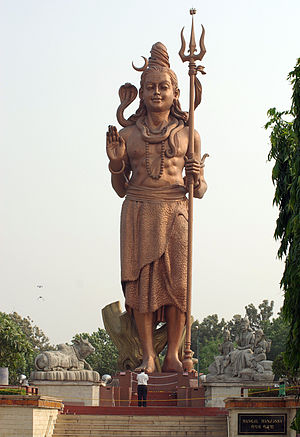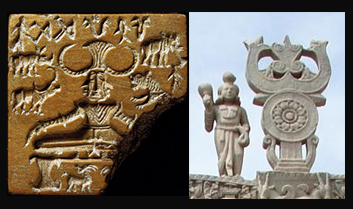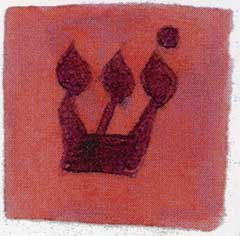Inside Buddhism’s Triple Refuge
बुद्धंशरणंगच्छामि। Buddhaṃ śaraṇaṃ gacchāmi I take refuge in the Buddha
धर्मंशरणंगच्छामि। Dharmaṃ śaraṇaṃ gacchāmi I take refuge in the Dharma
संघंशरणंगच्छामि। Sanghaṃ śaraṇaṃ gacchāmi I take refuge in the Sangha
 Shiva holding the Trishula, Sanga, Nepal
Shiva holding the Trishula, Sanga, NepalReligion is mankind’s most complex and enigmatic achievement. No one has yet to adequately define, explain, or categorize it, though many have tried. Perhaps the reason is that, from every vantage point we take on religion it offers a different meaning for us, imbuing us with imagery and feelings unique to our lives at the particular moment and time in which we participate with it. Buddhism’s Three Jewels offers a venue to explore this quintessential characteristic of religion since it’s at the heart of all schools of Buddhism, embraced by all Buddhists regardless of ethnicity, culture, and Buddhist school or sect. Also referred to as the Triple Refuge, it is considered the foundation of religious experience and indoctrinates one into the religious paradigm of Buddhism and, for some, into the realm of Chan.
When we begin our journey in Buddhism, we commit to “taking refuge” in three principles: the Buddha, the Dharma, and the Sangha. Taking refuge commonly means the act of going into something for shelter, protection, safety, etc. In a hail storm, for example, we might take refuge from being pommelled from falling projectiles by finding a roof to get underneath. Sometimes we need several refuges all at the same time. If we’re in a burning building we may need refuge from smoke, fire, heat and carbon monoxide if we are to survive. But unlike the hail storm or burning building, religious refuge is not for the physical body but for the spiritual body, and that place of refuge, we are told, is a trinity of things: in its simplest form it is the Buddha, his teachings (dharma), and, creating a recursive relationship, the group of like-minded people who have also embraced this three-fold refuge: the sangha.
 Left: Triratna on a Pashupati seal from Mohenjodaro, Pakistan. circa 2500 BCE - 2400 BCE; Right: The compound Buddhist symbols Shrivasta within a triratana, over a Dharmacakra wheel on the Torana gate at Sanchi. First century BCE.Early symbols depicting the three jewels, appeared commonly during the second and first centuries BCE, but there is evidence of symbolic origins as early as 2500 BCE. The earliest discovered appearance of the symbol found to-date is the triratna, a “W” shaped symbol resting on top of a wheel, or circle. This later became the trishula, a three-pronged spear resting above a lotus blossom, still commonly seen in Buddhist statuary, reliefs, and paintings.
Left: Triratna on a Pashupati seal from Mohenjodaro, Pakistan. circa 2500 BCE - 2400 BCE; Right: The compound Buddhist symbols Shrivasta within a triratana, over a Dharmacakra wheel on the Torana gate at Sanchi. First century BCE.Early symbols depicting the three jewels, appeared commonly during the second and first centuries BCE, but there is evidence of symbolic origins as early as 2500 BCE. The earliest discovered appearance of the symbol found to-date is the triratna, a “W” shaped symbol resting on top of a wheel, or circle. This later became the trishula, a three-pronged spear resting above a lotus blossom, still commonly seen in Buddhist statuary, reliefs, and paintings.
Interestingly, the ancient principle of three, and its symbolic representation, is still today an integral part of many religions, not just Buddhism.
Christianity embraces the holy trinity as the father, the son, and the holy ghost. The Christian symbol for the trinity is the fleur-de-lis which looks remarkably similar to the Buddhist and Hindu triratna.
 The Fleur-de-lis is a common symbol depicting the holy trinity in Christian religions. This is an antique Victorian Fleur-de-lis stained glass panel.Judaism embraces the trinity with the symbol shin, a three-pointed character that represents, according to Rabbi Aaron L. Raskin, “…the three pillars upon which the world stands: the study of Torah, prayer, and good deeds.”
The Fleur-de-lis is a common symbol depicting the holy trinity in Christian religions. This is an antique Victorian Fleur-de-lis stained glass panel.Judaism embraces the trinity with the symbol shin, a three-pointed character that represents, according to Rabbi Aaron L. Raskin, “…the three pillars upon which the world stands: the study of Torah, prayer, and good deeds.”
 Shin, depicting a mystical trinity, is a common symbol in Judaism.While the three-pronged symbol has changed little over millennia, regardless of whether or not it is connected to other similar symbols depicting a spiritual/religious-trinity, its fundamental meaning embraces a yearning in the human psyche for wholeness, a wholeness represented by three essential elements. What those elements are called in different religions may differ, but its numinous significance is irrefutable given its long and ubiquitous appearance in diverse cultures around the globe.
Shin, depicting a mystical trinity, is a common symbol in Judaism.While the three-pronged symbol has changed little over millennia, regardless of whether or not it is connected to other similar symbols depicting a spiritual/religious-trinity, its fundamental meaning embraces a yearning in the human psyche for wholeness, a wholeness represented by three essential elements. What those elements are called in different religions may differ, but its numinous significance is irrefutable given its long and ubiquitous appearance in diverse cultures around the globe.
Returning to our original topic; how might we, as individuals treading Buddhism’s spiritual journey, view the Buddhist trinity-- the Triple Jewel-- from the beginning, and how might that view evolve as our journey unfolds?
To tackle this it will be helpful to consider various “stages” we go through (assuming we don’t get stuck in any one of them along the way). Of course any “stage” we imagine is surely arbitrary since the journey is a continuous one from the beginning, but conceiving of “stages” helps us relate to the process of psychological and spiritual evolution.
While Chan Buddhism has its own representative stages of spiritual development as depicted by its set of ox-herding pictures with accompanying descriptive poems, they begin only once a yearning for mystical insight begins to manifest. James Fowler1 attempted to begin much earlier and describes six stages of spiritual development in Stages of Faith: The Psychology of Human Development and the Quest for Meaning. Chan’s ox-herding series overlaps with Fowler’s stages five and six, so between his six stages and Chan’s ox-herding stages we can construct a fairly complete model with which to examine the role of the Triple Jewel.
Fowler describes the beginning stage as Intuitive-Projective Faith - that belonging to the fantasy world of the very young child. While someone might offer the Triple Refuge to someone at this early stage of spiritual development, it will likely be received with a blank stare because there is no concept yet of self and other—their entire universe is egocentric, the outside world a shadow of a fantasy. While there are some adults in this stage, they are few compared to those in the next two stages.
Stage Two is Mythic-Literal Faith. Here we begin to identify with the belief system given to us by our parents, even though it seems fractured. This is where the individual first begins forming an identity through connecting with external belief structures. An individual offered the Triple Refuge by a parent or esteemed member of the community will gladly embrace it, but, lacking the ability to understand it, the intent will be to do what one is supposed to do to be accepted by the group. While the individual still exists dominantly within a self-absorbed world, he or she is beginning to yearn for acceptance from both family and community, and each opportunity to do so strengthens self-identity within the scope of a larger world which is just beginning to be discovered.
Stage Three is Synthetic Conventional Faith and we find a person in this stage yearning for strict belief structures. Once embraced, he will identify with them exclusively and repel any notions that do not fit within his confined world view. Often strongly opinionated, this person is neither individuated nor a “free thinker” but gauges himself exclusively within the context of his selected paradigm, whether it be religious, non-religious, or a-religious in nature. An individual in Stage Three will receive the Triple Refuge as a symbol of fully embracing Buddhism, with all the belief structures that accompany it. He will be fused to the specific Buddhist “school” (e.g., Tibetan, Korean, Japanese, Chinese, Mahayana, Vajrayana, etc.) he has affiliated himself with, and reject the others as being inferior or incorrect. The Triple Refuge is seen as applying only to his personal world and community: The Buddha is seen without abstraction, symbol, or metaphor but as a person who founded his embraced religion. The Dharma is seen as the teachings of the Buddha as presented by his local congregation and, to a lesser extent, the larger ethnic community as a whole. The Sangha is dominantly the group of members in his local Buddhist community and does not extend beyond it.
Stage Four is Individuative-Reflective Faith and is characterized by a "critical reflection on identity (self) and outlook (ideology)”. In this stage, a person relies dominantly on the thinking and reasoning process to help define and guide his life. The mind is “fact-based” over “feeling-based”. A person taking the Triple Refuge in this stage might do so for various ulterior purposes, its significance merely a hurdle to jump over to get to the other side. On the other side, such an individual will often seek to establish his own group through which he can be received as a leader and authority, make money, or in other ways gain respect, power, prestige, etc. In stage four, the mind’s eye has not yet glimpsed beyond one’s manufactured self-identity to a more all-inclusive aspect of self.2
Stage Five is Conjunctive Faith and happens when one begins to be receptive to seeing into the deeper nature of being. There remains, however, a rift in the psyche that results in a tension between one’s spiritual and banal identities. It is through this tension that one acquires the desire for a spiritual grounding-post, a way to resolve the tension, to become progressively more rooted within one’s essential nature. For such a person, the Triple Refuge takes on great significance. Taking refuge in the Buddha, one acknowledges the potential to become fully awake to one’s truest self, whatever that may be; taking refuge in the Dharma one acknowledges a commitment to take the teachings and practices of Buddhism as guides for further self-discovery and exploration; and taking refuge in the Sangha, one embraces the community of all like-minded individuals, as a family that shares the journey.
Chan’s ox-herding pictures/poems3 depicting stages of spiritual growth begin here with “searching for the ox”. Hsu Yun, the 20th century’s most famous Chan master, offered this verse:
I. Pushing Aside the Grass to Look for the Ox
Wanting to break through to Emptiness with my white cudgel
I cried out louder than the bellowing Ox,
mooing through my senses.
I followed mountain and stream searching for the Ox,
seeking it everywhere.
But I couldn't tell in which direction it had gone...
west?... or east?
Another Chan master, Kuo An Zhe, wrote:
I. Searching for the Ox
Alone in the wilderness, lost in the jungle, the boy is searching, searching!
The swelling waters, the far-away mountains, and the unending path;
Exhausted and in despair, he knows not where to go,
He only hears the evening cicadas singing in the maple-woods.
From the Chan perspective, prior to this stage a person is presumed a “hungry ghost,” i.e., living purely in an animalistic way, seeking to blindly satisfy desires through any and all means, at the mercy of the senses which rule over him (Buddhism’s six realms), completely detached and unaware of his true nature. The subsequent ox-herding pictures/poems all pertain to Fowler’s Stage Six (Buddhism’s seventh realm) which he considers the ultimate stage of spiritual development.
Stage Six is when awareness becomes inclusive of all being. In this stage one has transcended personal identity as the nexus of existence and now experiences life from the perspective of universal essence. The Triple Refuge takes on a boundless and all-encompassing nature for such a person. Taking refuge in the Buddha, one takes refuge in the essence of one’s True Self, one’s Buddha Nature, which is universal and infinite. Taking refuge in the Dharma one resides in the unifying essence of all things which are harmonious and follow natural universal laws. Taking refuge in the sangha, having ceased to differentiate between self and other, one perceives all people, in every walk of life, of every nationality, culture, age, and gender, collectively, as sangha. Every person is seen as an essential aspect of realty, all unified through Dharma. Even rocks, trees, planets and stars are seen as an aspect of Sangha as they equally share the existence of being. Hsu Yun expressed this feeling of wholeness, of unity, in a poem accompanying the tenth ox-herding picture:
X. Coming Home with Folded Hands
How wide are the horizons of the spinning earth!
The moonlight leads the tides and the sun's light will not be confined
within the net of heaven. But in the end all things return to the One.
The deaf and dumb, the crippled and deformed
are all restored to the One's Perfection.
The verse by Kuo An Zhe reads:
X. Entering the city with Bliss-bestowing Hands
Bare-chested and bare-footed, he comes out into the market-place;
Daubed with mud and ashes,how broadly he smiles!
There is no need for the miraculous power of the gods,
For he touches, and lo! the dead trees are in full bloom.
While Chan, Buddhism’s mystical school, begins at Fowler’s Stage Five, Buddhism offers a vehicle for exploration on life’s journey from wherever we are. Each of us who embraces it finds our home within it, and, as we move through our lives, Buddhism takes on progressively deeper and more profound significance as long as we stick with it and don’t arrest our progress by thinking we have “arrived,” that our understanding and awareness of it is complete.
As an example, imagine we are a young child and are shown a picture of a horse for the first time, never before having seen a horse. It is purely an abstraction of the reality of horse. How well can we know horse from a photo? In time, we watch a TV show and see the abstraction brought to life and we draw a connection between the abstraction and the possibility of a living, moving animal: its reality has become more apparent. In time, we visit a farm and see a live horse for the first time. The reality of horse is further developed as we smell it, touch it, hear it breathe, and look into its eyes. Yet how well do we really know the horse? In time, we take horseback riding lessons and learn to become “one” with the horse as we gallop across a field. How much more do we now know the horse? In time we have our own horse and take care of it with great affection, forming a close bond with it, and it with us. In time, the horse dies. As we reflect, we ask ourselves how well did we ever know the horse? Throughout our lives with horse we learned progressively more and more about it, at each stage, perhaps, having had the illusion that we knew all there was to know about it; yet there was always more. In the end, when the horse was gone, we learned something else about horse: it never existed as we conceived it; it was only our interpretation of it through personal sensory experiences that gave it the semblance of manifest reality. The essence of horse remains shrouded in mystery.
Like the horse, the mystery of the Triple Jewel unfolds as we travel ever deeper into its heart. And isn’t this the case whenever we explore anywhere? The lure of discovery propels us continuously into the unknown that we may become ever more whole. Perhaps this is an essential quality of religion, one that gives it its indefatigable hold on mankind?
 James Fowler1. From http://ethics.emory.edu/people/Founder.html: “James W. Fowler is a graduate of Duke University and Drew Theological Seminary and earned his Ph.D. at Harvard University in Religion and Society in 1971, with a focus in ethics and sociology of religion. He pursued post-doctoral studies at the Center for Moral Development at the Harvard Graduate School of Education (1971-72). He taught at Harvard Divinity School (1969-75) and at Boston College (1975-76). In 1977 he joined the faculty of Emory's Candler School of Theology. Emory named him the Charles Howard Candler Professor of Theology and Human Development in 1987.”
James Fowler1. From http://ethics.emory.edu/people/Founder.html: “James W. Fowler is a graduate of Duke University and Drew Theological Seminary and earned his Ph.D. at Harvard University in Religion and Society in 1971, with a focus in ethics and sociology of religion. He pursued post-doctoral studies at the Center for Moral Development at the Harvard Graduate School of Education (1971-72). He taught at Harvard Divinity School (1969-75) and at Boston College (1975-76). In 1977 he joined the faculty of Emory's Candler School of Theology. Emory named him the Charles Howard Candler Professor of Theology and Human Development in 1987.”
2. Some people in this stage are attracted to Chan because of a perceived logical/philosophical essence to it which appeals to their “critical reflection on identity”. For many, their interest lies dominantly in studying scripture wherein they believe lies the key to all Chan has to offer.
3. The famous “ox” of Chan’s ox-herding pictures represents one’s fundamental nature, one’s true self, Buddha Nature, which is initially unknown but becomes known through an ardent quest to discover it.
Further reading:
P'u Ming's Oxherding Pictures and Verses, 2nd Edition, by Red Pine
The Life Cycle Completed (Extended Version) by Erik H. Erikson and Joan M. Erikson
On this website:
